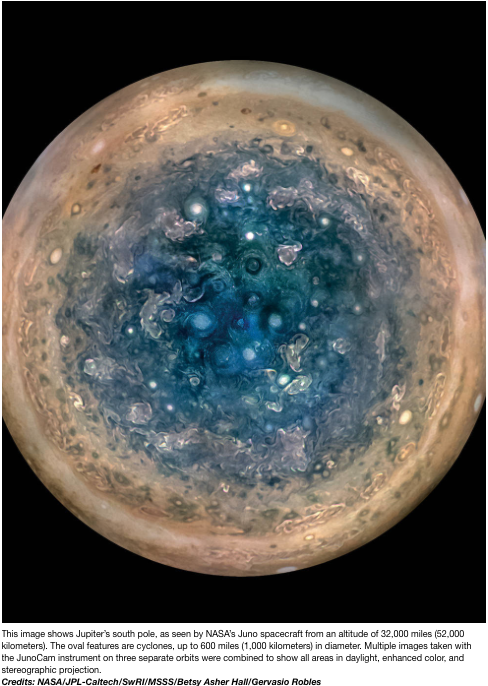
Juno is a NASA spacecraft orbiting the planet Jupiter. It was launched on 5th of August 2011 and entered a polar orbit of Jupiter on the 5th of July 2016. Juno is the second spacecraft to orbit Jupiter, after the Galileo orbiter, which mission lasted for eight years, from 1995 to 2003.
Prior to the Juno mission, scientists knew that Jupiter had the most intense magnetic field in the solar system. Using the magnetometer investigation (MAG) onboard Juno, the magnetic field was measured to be even stronger than models expected and more irregular in shape. Analysis of the data showed that the magnetic field of Jupiter is actually 10 times stronger than the strongest magnetic field found on Earth. It is also unevenly distributed, being stronger in some places and weaker in others.
Using Juno’s imager, JunoCam, astronomers discovered that both of the planet’s poles are covered in Earth-sized swirling storms. The mechanisms that created these storms and how stable they are remain unknown. It was also noticed that the north pole of Jupiter is very different from the south pole. Scientists still don’t know whether this is a dynamic system that is going to change over the next year, or is a stable configuration.
Juno is also equipped with a Microwave Radiometer (MWR) that samples the thermal microwave radiation from the atmosphere of Jupiter. The data collected showed that the iconic belt of the planet that is near the equator penetrates all the way down, while the belts and zones at other latitudes seem to evolve to other structures.
These are the main findings from the first data collection pass. Juno is also designed to study the polar magnetosphere and the origin of Jupiter’s powerful auroras. On July 11, Juno will fly directly over one of the most iconic features in the entire solar system, Jupiter’s Great Spot.
Source: NASA
